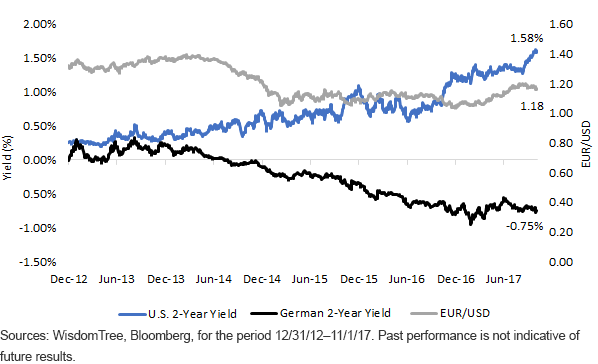Mario Draghi and the European Central Bank (ECB) provided some much-anticipated clarity on October 26 about the future of its asset purchase program following the governing council’s monetary policy meeting. We recently discussed the details of the ECB announcement here. In short, the planned taper had been well telegraphed ahead of time: the ECB will maintain accommodative financial conditions for the foreseeable future.
A low-rate environment coupled with an accelerating economic recovery provides a supportive backdrop for European equities, but the case for the direction of the currency is a bit more mixed. A review of how a dynamically hedged approach has responded to certain currency signals in recent history may provide some insights into how investors can approach a long-run strategic allocation to international investing.
Currency Signals
The ECB’s latest update on quantitative easing likely shelves any serious rate hike discussion until 2019, a plan that may help address one of the governing council’s concerns over the future of the recovery: a strengthening euro,1 up 11% relative to the dollar year-to-date.2 Interest rate differentials are a key driver of short-term currency movements. The “carry trade” leads investors to sell the lower-yielding currency (the euro) and buy the higher-yielding currency (the dollar) to earn the “carry” on the differential, leading to a relative appreciation of the higher-yielding currency. Following the October 26 announcement, the euro has dropped as much as 3.5% from its September 8 high on the year.3
EUR/USD and 2-Year Sovereign Debt Yields

In November 2015, WisdomTree launched a suite of dynamic currency-hedged Indexes with three signals, each with a one-third weight contributing to the hedge ratio, that are screened monthly: momentum, value and interest rate differentials. Since the inception of the WisdomTree Dynamic Currency Hedged Europe Equity Index in November 2015, a strategy designed to dial exposure to the euro up or down depending on the three signals, U.S. short-term rates have been higher than eurozone short-term rates. The above chart of 2-year sovereign yields in the U.S. and Germany shows how short-term interest rate differentials are related to why that rate signal applies a hedge to the euro currently.














Leave A Comment